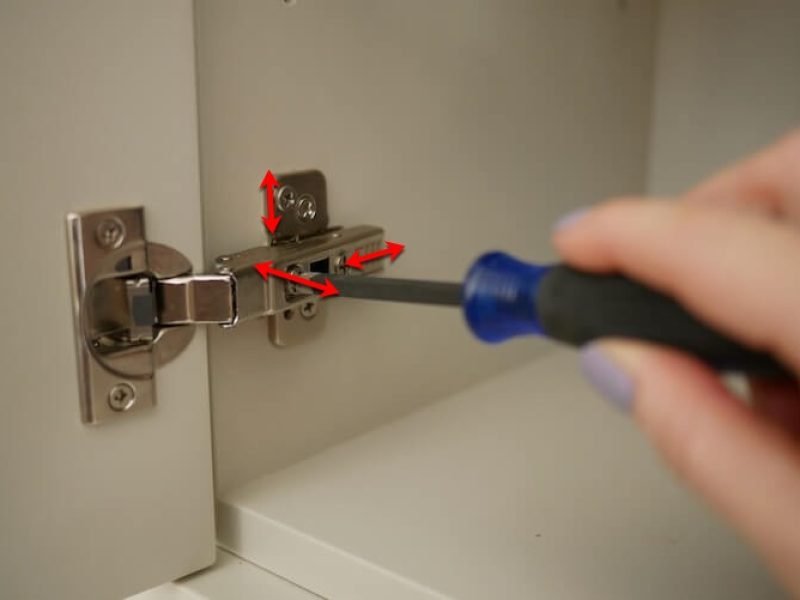European hinges, also known as concealed hinges, are a popular choice for cabinet doors due to their sleek design and easy installation. These hinges are hidden from view when the cabinet door is closed, creating a seamless look that many homeowners and designers prefer. In this blog, we will walk you through the steps to install European hinges on your cabinet doors.
Before we get started, it’s important to note that there are two main types of European hinges: face frame hinges and frameless hinges. Face frame hinges are designed for cabinets with a face frame, while frameless hinges are designed for cabinets without a face frame. Be sure to choose the appropriate type of hinge for your cabinets.
Tools and Materials You Will Need:
- European hinges
- Cabinet doors
- Screwdriver
- Drill
- Drill bits
- Measuring tape
- Pencil
- Masking tape
- Level
- Clamps (optional)
Step 1:
Determine Hinge Placement The first step in installing European hinges is to determine where to place the hinges on the cabinet door. Typically, two hinges are used per door, with one hinge near the top and one near the bottom.
To ensure that the hinges are installed at the same height on each door, measure and mark the placement for the top hinge first. Use a measuring tape to measure and mark the center of the cabinet door edge. Then, measure and mark the center of the hinge cup. The hinge cup is the part of the hinge that is inserted into the door. Once you have marked the center of the hinge cup, use a level to make sure that the mark is straight. Repeat this process for the bottom hinge placement.
Step 2:
Prepare the Cabinet Door With the hinge placement marked on the cabinet door, it’s time to prepare the door for installation. To prevent the drill from splintering the wood, place masking tape over the hinge placement marks. This will also help to keep the drill bit in place while you drill the holes. Next, measure the thickness of the cabinet door and choose a drill bit that is slightly smaller than the diameter of the screws that came with your European hinges.
Step 3:
Drill Holes in the Cabinet Door With the drill bit and screws ready, use a drill to create holes in the cabinet door where you marked the hinge placement. Be sure to drill straight and at the correct angle for your particular hinge type. For face frame hinges, the hole should be drilled at a 90-degree angle to the cabinet door, while for frameless hinges, the hole should be drilled at a 45-degree angle. Once the holes are drilled, remove the masking tape.
Step 4:
Install the Hinge Baseplate Now it’s time to install the hinge baseplate onto the cabinet door. The baseplate is the part of the hinge that attaches to the cabinet door. Align the baseplate with the holes you drilled in the previous step, and then use the screws provided with the hinges to attach the baseplate to the door. Be sure to tighten the screws securely, but not too tightly, as this can strip the screw holes.
Step 5:
Attach the Hinge Cup With the baseplate securely attached to the cabinet door, it’s time to insert the hinge cup into the baseplate. Insert the hinge cup into the baseplate, making sure that it is securely locked in place. Then, use the screws provided with the hinge to attach the hinge cup to the baseplate. Again, be sure to tighten the screws securely, but not too tightly.
Step 6:
Attach the Cabinet Door to the Cabinet With the hinge installed on the cabinet door, it’s time to attach the door to the cabinet. If you have a face frame cabinet, align the hinge with the pre-drilled holes in the face frame and attach it using the screws provided. If you have a frameless cabinet, use a cabinet jig to help you position the hinge on the cabinet side panel. Align the hinge with the pre-drilled holes in the cabinet side panel and attach it using the screws provided.
Step 7:
Adjust the Hinges After attaching the cabinet door to the cabinet, you may need to adjust the hinges to ensure that the door hangs straight and opens and closes smoothly. Most European hinges have adjustment screws that can be used to adjust the door height, depth, and side-to-side position. Use a screwdriver to make these adjustments as needed.
Step 8:
Repeat the Process for Other Cabinet Doors Once you have successfully installed the European hinge on one cabinet door, repeat the process for the other doors. Be sure to measure and mark the hinge placement on each door individually, as slight variations in door size and position can affect hinge placement.
Conclusion
Installing European hinges on your cabinet doors is a simple process that can be completed with basic tools and materials. By following these steps, you can achieve a seamless and modern look for your cabinets. If you need any assistance or have any questions about European hinges, feel free to contact our team at FurniHard. We offer a wide range of high-quality European hinges and other cabinet hardware products that can help you achieve your desired look.

FAQs
Here are 10 FAQs about installing European hinges on cabinet doors:
What are European hinges?
European hinges, also known as concealed hinges, are hinges that are hidden from view when the cabinet door is closed, creating a seamless and modern look.
What tools do I need to install European hinges?
To install European hinges, you will need a screwdriver, drill, drill bits, measuring tape, pencil, masking tape, level, and clamps (optional).
How do I choose the right type of European hinge?
There are two main types of European hinges: face frame hinges and frameless hinges. Face frame hinges are designed for cabinets with a face frame, while frameless hinges are designed for cabinets without a face frame. Choose the appropriate type of hinge for your cabinets.
How do I determine where to place the hinges on the cabinet door?
Measure and mark the center of the cabinet door edge, then measure and mark the center of the hinge cup. Use a level to make sure that the mark is straight. Repeat this process for the bottom hinge placement.
How do I prepare the cabinet door for installation?
To prevent the drill from splintering the wood, place masking tape over the hinge placement marks. Measure the thickness of the cabinet door and choose a drill bit that is slightly smaller than the diameter of the screws that came with your European hinges.
How do I drill holes in the cabinet door?
Use a drill to create holes in the cabinet door where you marked the hinge placement. For face frame hinges, the hole should be drilled at a 90-degree angle to the cabinet door, while for frameless hinges, the hole should be drilled at a 45-degree angle.
How do I install the hinge baseplate?
Align the baseplate with the holes you drilled in the previous step, and then use the screws provided with the hinges to attach the baseplate to the door. Be sure to tighten the screws securely, but not too tightly, as this can strip the screw holes.
How do I attach the hinge cup?
Insert the hinge cup into the baseplate, making sure that it is securely locked in place. Then, use the screws provided with the hinge to attach the hinge cup to the baseplate. Again, be sure to tighten the screws securely, but not too tightly.
How do I adjust the hinges?
Most European hinges have adjustment screws that can be used to adjust the door height, depth, and side-to-side position. Use a screwdriver to make these adjustments as needed.
Where can I buy European hinges?
You can buy high-quality European hinges and other cabinet hardware products from FurniHard. Our team can assist you in selecting the right hinges for your cabinets and provide support throughout the installation process.

